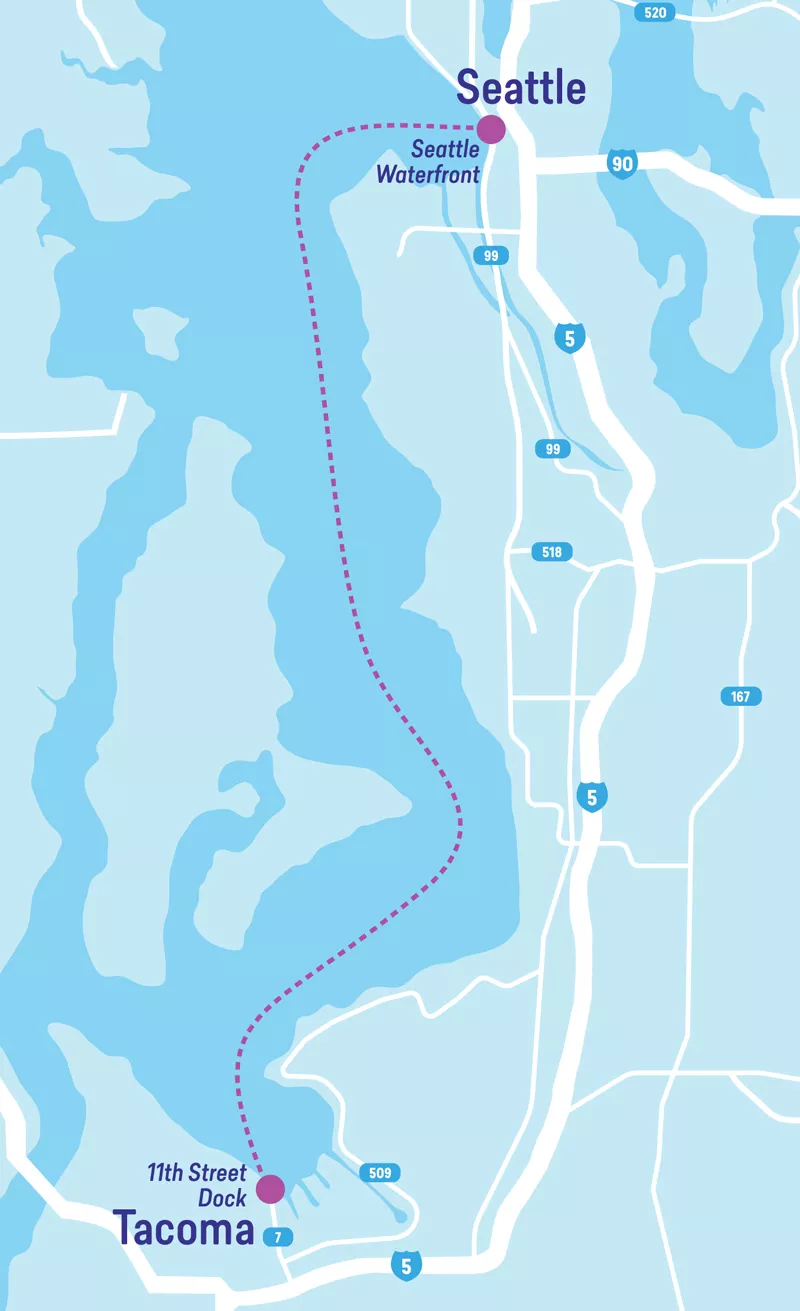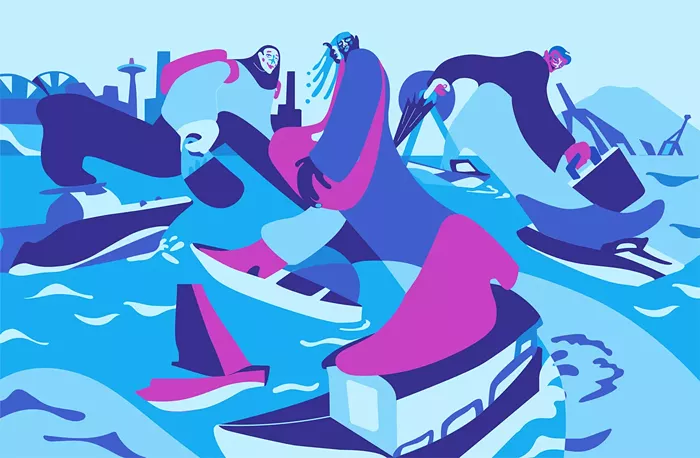We are so moist and soggy in this area. Majestic Puget Sound, glorious Elliott Bay, all those big, juicy lakes, and the super fun(d) Duwamish River. It’s a lot of water and shoreline—1,600 miles in Seattle and on Puget Sound—and it’s just sitting there.
Why not plop a few boats down and call it a passenger ferry system? New York did it.
Unlike New York, we’re already ferry-philes. For the past 15 years, we’ve had a few walk-on passenger-only ferries. And our car-ferry system is the largest in the US, with 21 vessels and 10 routes. It carried 19.1 million passengers last year alone (about two-thirds of light-rail ridership) despite the ferries sucking rocks lately. Thanks, aging fleet and pandemic-era chaos.
Imagine catching a ferry from downtown Seattle to Tacoma and being blinded by sea spray instead of brake lights on I-5. Or criss-crossing Lake Washington on a boat, without dealing with the traffic on a floating bridge.
This imagined future is our past. Between the 1880s and 1920s, a slipshod armada of steamships known as the Mosquito Fleet zipped people across the region’s waterways. There were no cars, no bridges, and few roads. Estimates of the Mosquito Fleet’s size vary from 700 to 2,500 ships. There were more than 300 regular stops, but the boats tended to pick up and drop off people anywhere. Boats were our primary people-mover for decades, but the mass production of cars squashed the fleet.
But there’s buzz from local wonks, ferry enthusiasts, and politicians who believe we can revive the dream of the Mosquito Fleet. Studies show new ferry routes could better connect the region, cut commutes, and add resiliency to the existing transportation network if emergencies shut down other options.
It’d take a lot to make that dream a reality.
Tim Eyman Hates Your Ferry Route
Despite the Seattle area’s wet roots and Mosquito Fleet past, we only just reintroduced passenger ferries.
The Puget Sound region has five publicly run, passenger ferry routes. King County started running the Water Taxi in 2009. In 2017, Kitsap Transit added routes to downtown Seattle from Kingston, Bremerton, and Southworth.
Starting in 1989, Washington State Ferries (WSF) had passenger ferries between West Seattle and Bremerton, and Seattle and Vashon Island. Then 1999 happened.
In that fateful year, 113 Bremerton residents sued the state, alleging the ferry’s wake damaged the shoreline along Bremerton’s narrow Rich Passage. The plaintiffs won in 2002. The state coughed up $4.5 million in damages and slowed down the passenger ferry so much that it eliminated its appeal. Ridership plummeted.
In that same terrible year, voters approved Initiative 695, lowering vehicle excise taxes to $30, thus decimating transportation funding and unleashing the hydra that is anti-tax activist Tim Eyman and his fixation on those darn car tabs.
Josh Brown, executive director of the Puget Sound Regional Council, says that initiative all but sank the financial resources for state-run passenger ferries. The state stayed in its car ferry lane. They’re considered an extension of the state highway system, so funds are available.
Eventually, local jurisdictions took control. King County created its own ferry district and passed a property tax to fund the Water Taxi. After Kitsap Transit lobbied the state to put ferry funding on the ballot, voters approved a proposed sales tax increase.
What Happened in Kitsap
Passing that ballot measure in 2016 took work, says Steve Sego, a developer and member of the coalition Friends of the Fast Ferry who lobbied to pass it.
Sego grew up in Kitsap County and has fond memories of hearing the ferry’s foghorn as it sailed through Rich Passage near his childhood home. He returned to the region after 35 years and expected to find an extensive ferry network.
“It was not only not improving, it was going backwards in service,” Sego says.
Thanks, in part, to Sego, WSF had the Kitsap Fast Ferry to fill service gaps post-COVID. Washington even funded increased trips along the Bremerton route.
However, with WSF service rebounding, the fast ferry Saturday service to Bremerton is on the chopping block, which is wild because people fucking love it. Last year, all that backfilling boosted the route’s ridership numbers 68 percent over what they were two years earlier. Sego says thousands of people have told him the Kitsap routes have improved their lives. Passenger ferries travel twice the speed of car ferries. They also deemphasize car travel, which certainly doesn’t hurt the atmosphere. And they connect car-less passengers with trains and buses.
“It’s not just an economic benefit and practical benefit, but it’s a lifestyle and quality of life benefit as well,” Sego says. “The rest of the Puget Sound benefits from having those options.”
New Routes, Same Shit
Setting up new routes should be easy. Look at New York City. In the 1900s, the city had and lost a passenger ferry network. And in 2017, Mayor Bill de Blasio established a new five-borough ferry system.
“We do have communities exploring expanded routes today,” Brown says. In 2021, he and his team at Puget Sound Regional Council released their recommendations for new passenger ferry routes, which they based on potential demand, time saved on commutes, and connections to other transit.
They suggested a route from downtown Seattle to Tacoma, Lake Washington routes connecting Kenmore, Kirkland, and Renton to the University of Washington, and another between Renton and South Lake Union, all of which would save commute time compared to existing transit options. But the routes face two big barriers, Brown says. Money and space.
A new transportation system would cost serious bucks, and we never have enough for transit in this state. That constant problem makes legislators pause when considering new passenger ferries.
King County Councilmember Claudia Balducci certainly sees the benefits of the water taxis from Seattle to West Seattle and Seattle to Vashon Island; they’re not only popular, but connect the region. But Balducci thinks people get “very excited” about the open water, maybe too much. She doesn’t think those ferry routes make sense when we could invest in buses and trains, which are effective, efficient, and move more people. Ferries, Balducci says, can look like tourism rather than transit.
“It’s not what we should be using our precious transit dollars for,” she says. “Nothing against boats. I love boats.”
New York’s new ferry system is kept afloat by big, fat city subsidies that cost taxpayers “nearly a quarter-billion more than officials reported” in a game of hide the numbers, according to amNY. Ferry ridership reached record highs this year, but it is still less than 1 percent of the ridership on NYC’s subways. According to a study from the Puget Sound Regional Council, the route from Seattle to Tacoma would only carry 73,300 passengers a year. The suburban routes on the high end of PSRC’s estimates—UW to Kenmore and UW to Kirkland—would serve around 300,000 people annually. That’s not much.

A Dock? My Kingdom for a Dock
Kitsap Transit Executive Director John Clauson is in the middle of a protracted bid for a dedicated Seattle terminal for the agency’s passenger ferries. Right now, Kitsap Transit shares a downtown dock with the King County Water Taxi that’s only big enough for two vessels. Kitsap has three routes and King County has two, and because it’s Seattle’s dock, Seattle gets priority, Clauson says. Jockeying for a dock is hard, and a Google calendar won’t fix it
But even finding a space for this terminal is a nightmare. The three potential spaces are owned by different entities: the Port of Seattle, the City of Seattle, and the state.
Clauson’s job exemplifies the real problem with the Mosquito Dream—land ownership. The shoreline is a patchwork of deeds and titles. Consider the hypothetical route to South Lake Union. Do you work out a deal with the Museum of History and Industry, which owns a chunk of dock space, or with that houseboat neighborhood, or maybe the float plane company?
The issue with the Lake Washington routes isn’t the dock space in suburbs like Kenmore or Renton, but near UW. A dock could interrupt recreational boating near the Montlake Cut and impede UW’s rowing team. Would the boys in the boat really allow a ferry to interrupt their training path? Would George Clooney? Anyone serious about building that route would need to find out.
“You kind of look at the just the analysis, and you realize, ‘Wow, this may be a tougher ask of the public than what I was accounting for,’” Brown says.
Sego, ever the optimist, believes the dock challenges are surmountable. He noted that New York’s ferry system has smaller docks and boats with variable loading mechanisms.
“It’s really efficient,” Sego says. “You don’t have to overthink this.”




